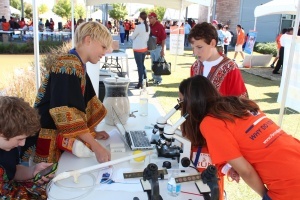Mary Binkley teaches Math/Science Enrichment and is the Junior United Nations faculty sponsor at Homewood Middle School in Birmingham, Alabama. She coordinated her students’ work on the Village in Action at the recent Birmingham Partnership Walk.

Homewood students John-Phillip McMullan, Sam Janas, and Avery Stansell demonstrate water purification and its effects.
“The great gift of human beings is that we have the power of empathy.” — Meryl Streep
Visitors to the Birmingham Partnership Walk’s Village in Action exhibit may have been surprised to find the high school-aged students who ran the Village in years past replaced by younger sixth- and seventh-grade students from Homewood Middle School. This year marked the first time that the Birmingham Partnership Walk team and the Homewood Middle School’s Junior United Nations (JUNA) team partnered to produce a mock global village that highlighted philanthropic projects implemented by the Aga Khan Foundation.
Here’s how it looked: As you walked into the Village, a team of students presenting the traveling kindergarten program in Kyrgyzstan, invited you to sit with them in their tent on a carpet while they read Three Sad Wizards, a children’s book commissioned by the Aga Khan Foundation in Kyrgyzstan that promotes tolerance, peace, and respect for diversity.
In the next tent, students distributed tree seeds while taking the visitors through a presentation on the impact of microforestry in Kenya, a concept that the students studied in order to communicate to their audience. “Before we put together our presentation, I had no idea what microforestry was, and now I’m teaching other people about it,” said Eliza Angelo, a sixth-grader on the team from Homewood Middle. “We had to think about what would make people attracted to our booths.” She noted that visitors ranged from small children to city dignitaries.
The third tent educated visitors on an education and nutrition program in Tajikistan. A small group of students had participated in the 2012 Village showcasing this project and were dedicated to improving the presentation.
On the other side of the Village, two tents showcased Water Purification in Kenya and Renewable Energy from the Bujagali Dam in Uganda. The ponds in Birmingham’s Railroad Park provided the perfect backdrop to display the simple systems that allow rural Kenyans access to clean water, as well as a model of the Bujagali Dam construction. The Homewood JUNA team, 20 students in all, wore costumes from past JUNA events to make their presentations even more engaging for everyone who came through the Village. Finally, at each spot, visitors received a sticker in a small passport that allowed them to add their handprint to a community art project at the end.
The students spent four weeks researching, preparing, and rehearsing quick mini-lessons and visuals that help visitors to the village understand the impact of projects that alleviate poverty around the world. Preparing to educate others about these initiatives helped them to develop a new understanding of poverty in developing nations. Through building models, writing scripts, and creating presentations, the students became more aware of the challenges faced daily by people who have no access to electricity, clean water, education, or a viable income.
Anna Katherine Pitts, another sixth-grade team member, said she gained a more open mind. “The Walk opened up my eyes to see how other people in different countries are in so much need and how much the Aga Khan Foundation has helped them.”
The experience helped to develop global citizenship in the JUNA team. It is their hope that they can continue their partnership in years to come.